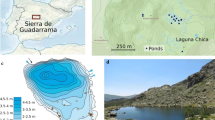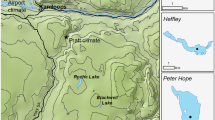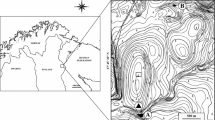Abstract
In Lake Ringsjön, southern Sweden, we estimated yearly variations in both 0+ and older fish abundances, following the fish reductions in 1988–1992. Between 1987 and 1994, the total planktivore biomass decreased fourfold whereas the abundance of 0+ fish increased twenty times. The resulting change in predation pressure from planktivorous fish on zooplankton increased up to 2–3 times, after the fish reduction. We conclude that after an initial decrease, the predation pressure on zooplankton increased considerably due to the increase in 0+ fish abundance. The expansion in juvenile fish abundance may therefore have been an important factor behind the apparent lack of top-down effect on the zooplankton community following biomanipulation of Lake Ringsjön. The horizontal distribution of 0+ fish in Lake Ringsjön is also discussed.
Similar content being viewed by others
References
Benndorf, J., 1995. Possibilities and limits for controlling eutrophication by biomanipulation. Int. Rev. ges. Hydrobiol. 80: 519–534.
Bergman, E. & E. Bergstrand, 1999. Lack of a top-down effect on the zooplankton community after a cyprinid fish reduction. Hydrobiologia 404: 77–87.
Bergman, E., 1999. Changes in the nutrient load and lake water chemistry in Lake Ringsjön, southern Sweden, from 1966 to 1996. Hydrobiologia 404: 9–18.
Bergman, E., S. F. Hamrin & P. Romare, 1999. The effects of cyprinid reduction on the fish community. Hydrobiologia 404: 65–75.
Boersma, M., O. F. R. van Tongeren & W. M. Mooij, 1996. Seasonal patterns in the mortality of Daphnia species in a shallow lake. Can. J. Fish. aquat. Sci. 53: 18–28.
Carpenter, S. R. & D. M. Lodge, 1986. Effects of submersed macrophytes on ecosystem processes. Aquat. Bot. 26: 341–370.
Cryer, M., G. Peirson & C. R. Townsend, 1986. Reciprocal interactions between roach, Rutilus rutilus, and zooplankton in a small lake: prey dynamics and fish growth and recruitment. Limnol. Oceanogr. 31: 1022–1038.
Diehl, S. & P. Eklöv, 1995. Effects of piscivore-mediated habitat use on resources, diet, and growth of perch. Ecology 76: 1712–1726.
Hamrin, S. F., 1999. Planning and execution of the fish reduction in Lake Ringsjön. Hydrobiologia 404: 59–63.
Hansson, L.-A., M. Enell & E. Bergman, 1999. Lake Ringsjön: its catchment area, its history and its importance. Hydrobiologia 404: 1–7.
Jachner, A., 1991. Food and habitat partitioning among juveniles of three fish species in the pelagial of a mesotrophic lake. Hydrobiologia 226: 81–90.
Karjalainen, J., D. Miserque & H. Huuskonen, 1997. The estimation of food consumption in larval and juvenile fish: experimental comparison of two methods. J. Fish Biol. (Suppl.) in press.
Keast, K., 1988. Planktivory in larval, juvenile, and adult planktivores: resource division in a small lake. Verh. Int. Ver. Limnol. 23: 1692–1697.
Kerfoot, W. C., 1987. Cascading effects and indirect pathways. In W. C. Kerfoot & A. C. Sih (eds), Predation: Direct and Indirect Impacts on Aquatic Communities. The University Press of New England, Hanover (N.H.): 57–70.
Lessmark, O., 1983. Competition between perch (Perca fluviatilis) and roach (Rutilus rutilus) in south Swedish lakes. Ph. D. thesis, Univ. of Lund, Lund.
Lodge, D. M., J. W. Barko, D. Strayer, J. M. Melack, G. G. Mittelbach, R. W. Howarth, B. Menge & J. E. Titus, 1988. Spatial heterogeneity and habitat interactions in lake communities. In S. R. Carpenter (ed), Complex Interactions in Lake Communities. Springer-Verlag, New York: 181–208.
Marmulla, G. & R. Rösch, 1990. Maximum daily ration of juvenile fish fed living natural zooplankton. J. Fish. Biol. 36: 789–801.
Mehner, T., H. Schultz & R. Herbst, 1995. Interactions of zooplankton dynamics and diet of 0+ perch (Perca fluviatilis L.) in the top-down manipulated Bautzen Reservoir (Saxony, Germany) during summer. Limnologica 25: 1–9.
Mehner, T., M. Plewa, S. Hülsmann, H. Voigt & J. Benndorf, 1997. Age-0 fish predation on daphnids – spatial and temporal variability in the top-down manipulated Bautzen Reservoir, Germany. Arch. Hydrobiol. Spec. Issues Advanc. Limnol. 49: 13–25.
Meijer, M-L., E. Jeppesen, E. van Donk, B. Moss, M. Scheffer, E. Lammens, E. van Nes, J. A. van Berkum, G. J. De Jong, B. A. Faafeng & J. P. Jensen, 1994. Long-term responses to fishstock reduction in small shallow lakes: interpretation of five-year results of four biomanipulation cases in The Netherlands and Denmark. Hydrobiologia 275/276: 457–466.
Mills, E. L., J. L. Forney & K. J. Wagner, 1987. Fish predation and its cascading effect on the Oneida lake food chain. In W. C. Kerfoot & A. C. Sih (eds), Predation: Direct and Indirect Impacts on Aquatic Communities. The University Press of New England, Hanover (N.H.): 118–131.
Mooij, W. M., E. H. R. R. Lammens & W. L. T. van Densen, 1994. Growth rate of 0+ fish in relation to temperature, body size, and food in shallow eutrophic lake Tjeukemeer. Can. J. Fish. Aquat. Sci. 51: 516–526.
Persson, L. & L. A. Greenberg, 1990. Juvenile competitive bottlenecks: the perch (Perca fluviatilis) – roach (Rutilus rutilus) interaction. Ecology 71: 44–56.
Persson, L., 1991. Behavioral response to predators reverses the outcome of competition between prey species. Behav. Ecol. Sociobiol. 28: 101–105.
Persson, L., 1997. Competition, predation and environmental factors as structuring forces in freshwater fish communities: Sumar (1971) revisited. Can. J. Fish Aquat. Sci. 54: 85–88.
Persson, L., S. Diehl, L. Johansson, G. Andersson & S. F. Hamrin, 1991. Shifts in fish communities along a productivity gradient of temperate lakes – patterns and the importance of size-structured interactions. J. Fish. Bio. 38: 281–293.
Post, D. M. & J. F. Kitchell, 1997. Trophic ontogeny and life history effects on interactions between age-0 fishes and zooplankton. Arch. Hydrobiol. Spec. Issues Advanc. Limnol. 49: 1–12.
Post, J. R., 1990. Metabolic allometry of larval and juvenile yellow perch (Perca flavescens): in situ estimates and bioenergetic models. Can. J. Fish. Aquat. Sci. 47: 554–560.
Qin, J. & D. A. Culver, 1995. Effect of young-of-the-year walley (Percidae: Stizostedion vitreum) on plankton dynamics and water quality in ponds. Hydrobiologia 297: 217–227.
Spaak, P. & J. R. Hoekstra, 1994. Population dynamics of a Daphnia hybrid species complex in Tjeukemeer. In P. Spaak, Genetical Ecology of a coexisting Daphnia hybrid species complex. Ph. D. thesis, University of Utrecht, the Netherlands: 97–116.
Strand, J., 1999. The development of submerged macrophytes in Lake Ringsjön after biomanipulation. Hydrobiologia 404: 113–121.
Taleb, H., P. Reyes-Marchant & N. Lair, 1994. Effect of vertebrate predation on the spatio-temperal distribution of cladocerans in a temperate eutrophic lake. Hydrobiologia 294: 117–128.
Thiel, R., 1996. The impact of fish predation on the zooplankton community in a southern Baltic bay. Limnologica 26: 123–137.
Treasurer, J.W., 1990. The food and daily consumption of lacustrine 0+perch, Perca fluviatilis L. Freshwat. Biol. 24: 361–374.
van Densen, W. L. T., 1985. Feeding behaviour of major 0+fish species in a shallow, eutrophic lake (Tjeukemeer, The Netherlands). Z. Angew. Ichthyol. 2: 49–70.
Wang, N. & R. Eckmann, 1994. Distribution of perch (Perca fluviatilis L.) during their first year of life in Lake Constance. Hydrobiologia 277: 135–143.
Wanzenböck, J., J. Matena & J. Kubecka, 1997. Comparison of two methods to quantify pelagic early life stages of fish. Arch. Hydrobiol. Spec. Issues Advanc. Limnol. 49: 117–124.
Whiteside, M. C. & J. T. Hatch, 1997. Quantitative sampling techniques for age-0 fish from diverse lake habitats. Arch. Hydrobiol. Spec. Issues Advanc. Limnol. 49: 99–116.
Whiteside, M. C., 1988. 0+ fish as major factors affecting abundance patterns of littoral zooplankton. Verh. Int. Ver. Limnol. 23: 1710–1714.
Vijverberg, J., M. Boersma, W. van Densen, W. Hoogenboezem, E. H. R. R. Lammens & W. M. Mooij, 1990. Seasonal variation in the interactions between piscivorous fish, planktivorous fish and zooplankton in a shallow eutrophic lake. Hydrobiologia 207: 279–286.
Zalewski, M., B. Brewinska-Zaras, P. Frankiewicz & S. Kalinowski, 1990. The potential for biomanipulation using fry communities in a lowland reservoir: concordance between water quality and optimal recruitment. Hydrobiologia 200/201: 549–556
Author information
Authors and Affiliations
Rights and permissions
About this article
Cite this article
Romare, P., Bergman, E. Juvenile fish expansion following biomanipulation and its effect on zooplankton. Hydrobiologia 404, 89–97 (1999). https://doi.org/10.1023/A:1003731128746
Issue Date:
DOI: https://doi.org/10.1023/A:1003731128746




